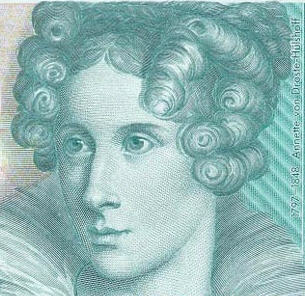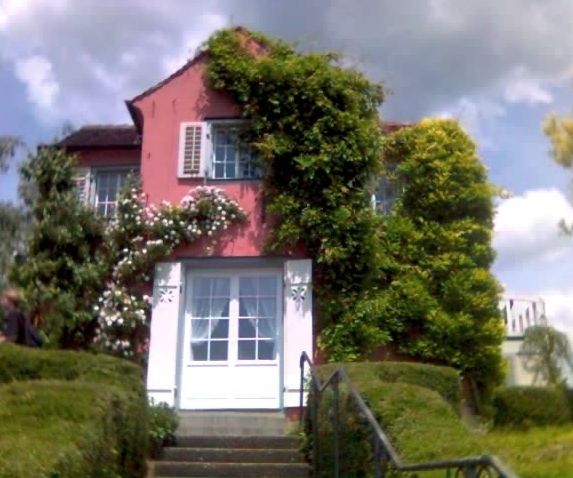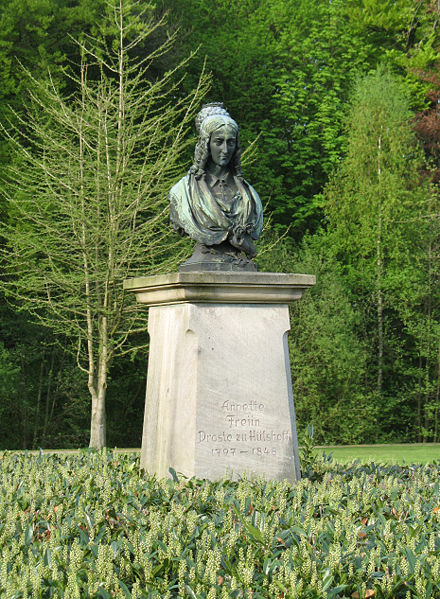Annette von Droste-Hülshoff

Annette von Droste-Hülshoff on the Twenty Deutsche Mark banknote

House of Annette von Droste-Hülshoff in Meersburg (Germany).The title of this article contains the character ü. Where it is unavailable or not desired, the name may be represented as Annette von Droste-Huelshoff.
Annette von Droste-Hülshoff (help·info) (IPA: [aˈnɛtə fɔn ˈdʁɔstəˈhʏlshɔf]; January 10, 1797 – May 25, 1848) was a 19th century German author, and one of the most important German poets.
She was born at the family seat of Hülshoff near Münster into an aristocratic, Catholic family in Westphalia. She was educated by private tutors and began to write as a child, but did not publish any of her work until she was forty years old. Among her best-known writings are the cycle of poems Das geistliche Jahr (The Spiritual Year) and the novella Die Judenbuche (The Jew’s Beech).
Her early intellectual training was largely influenced by her cousin, Clemens August Freiherr von Droste zu Vischering, who, as archbishop of Cologne, became notorious for his extreme ultramontane views (see below). She received a wider liberal education than was common for women of her time.
Despite her withdrawn and restricted life she corresponded with intellectual contemporaries such as the Brothers Grimm. As her health continually worsened, earning a living through her writing was never an option. Despite this, she took her literary work very seriously.
She was able to break from her circumstances during a trip to Lake Constance, originally only to visit relatives. From 1841 she stayed with her brother-in-law, Joseph von Laßberg at Schloss Meersburg. In 1837 she became friends with the author Levin Schücking, who, through her agency, became the librarian at Schloss Meersburg.
Annette von Droste-Hülshoff is (according to the article in Encyclopaedia Britannica 1911) beyond doubt the most gifted and original of German women poets. Her verse is strong and vigorous, but often unmusical, if not to say harsh; one looks in vain for a touch of sentimentality or melting sweetness in it. That this harshness in a way reflects her conditions as a woman in 19th century Germany can be seen in poems like “Am Turme” (http://www.wortblume.de/dichterinnen/amturme.htm). As a lyric poet, she is at her best when she is able to attune her thoughts to the sober landscape of the Westphalian moorlands of her home. Her narrative poetry, and especially Das Hospiz auf dem Großen St. Bernard and Die Schlacht im Loener Bruch (both 1838), belongs to the best German poetry of its kind. She was a strict Roman Catholic, and her religious poems, published in 1852, after her death, under the title Das geistliche Jahr, nebst einem Anhang religiöser Gedichte, enjoyed great popularity.
Annette von Droste-Hülshoff died in May 1848 at Schloss Meersburg, probably from pneumonia.

Annette von Droste memorial in the garden of the Hülshoff castle in Havixbeck, Germany
Works
Burg Hülshoff in Havixbeck, Germany: birth-place of Annette von DrosteGedichte, 1838
Die Judenbuche (novella), 1842
Gedichte (Poems), 1844
Westfälische Schilderungen (Westphalian Illustrations), 1845
Das geistliche Jahr (The Spiritual Year, cycle of poems), 1851
Der Knabe im Moor (The Lad on the Moor, ballad)
Letzte Gaben (Last Gifts, poems), 1860
Briefe von Annette von Droste-Hülshoff und Levin Schücking (Letters from Annette von Droste-Hülshoff and Levin Schücking)
References
“Annette Elisabeth, Baroness von Hülshoff”. Catholic Encyclopedia. (1913). New York: Robert Appleton Company.
This article incorporates text from the Encyclopædia Britannica Eleventh Edition, a publication now in the public domain.
Some of the material for this article comes from the equivalent German-language Wikipedia article. It cites:
P. Berglar: Annette von Droste-Hülshoff. Rowohlt Verlag, Reinbek 1967
Levin Schücking: Annette von Droste. Stuttgart 1964
E. Staiger: Annette von Droste-Hülshoff. Frauenfeld 1967


